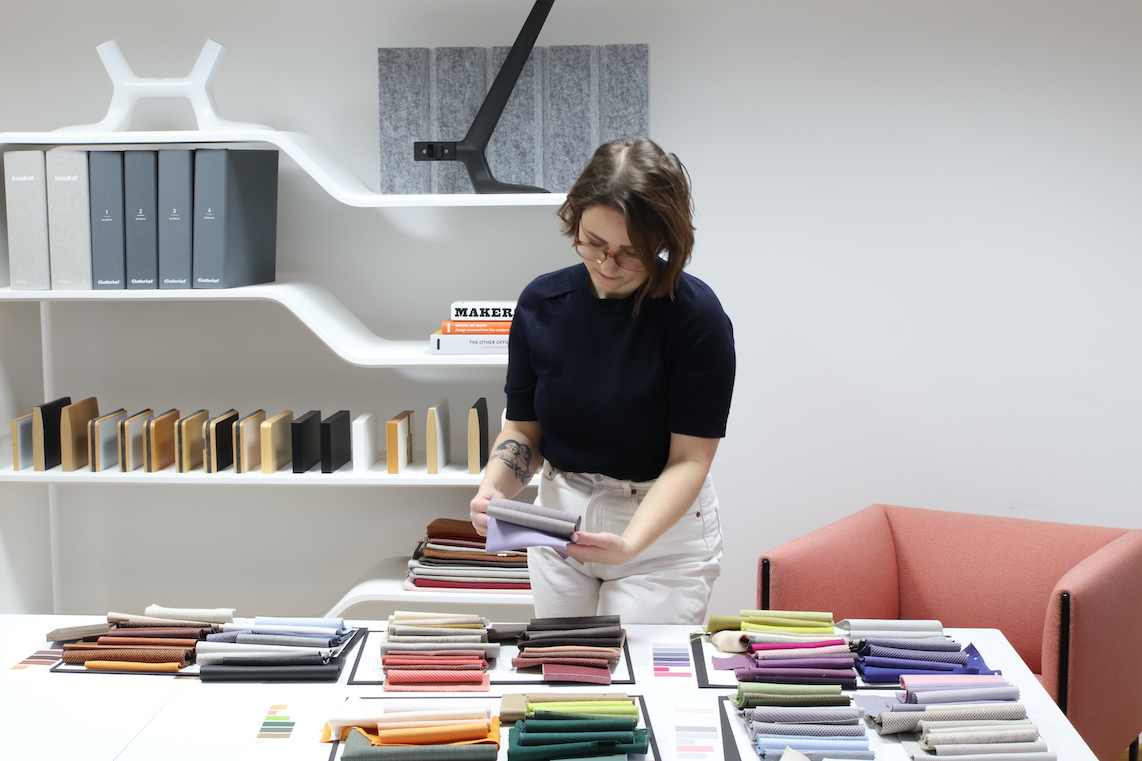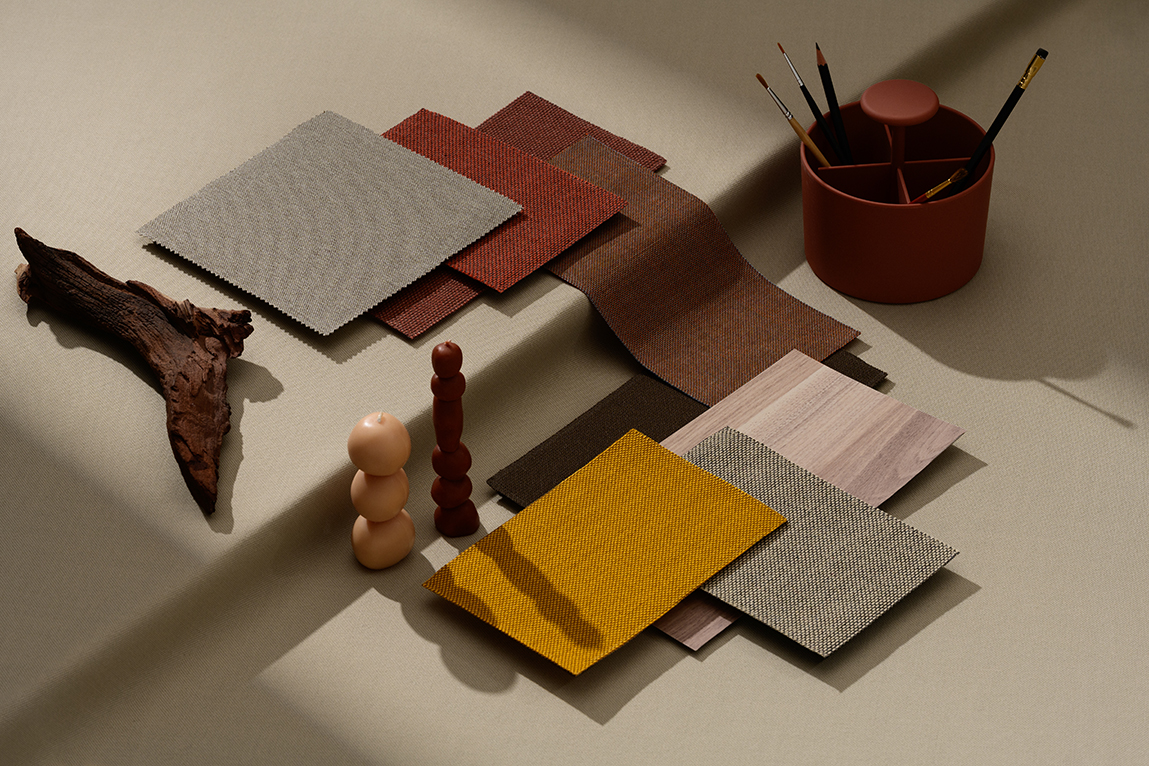Mood boards are starting blocks in the development of new design concepts. They offer inspiration and guidance for the creation of an attractive image and a visual direction. At Wilkhahn, Alina Schnizler frequently develops new mood boards . During our interview, she revealed some of the development process that straddles traditions and trends – and gives some practical tips for creating mood boards.

Alina, you design mood boards at Wilkhahn – where do you start?
It’s important to mention that there are a few basic rules, but no magic solution. In my case, working on mood boards and defining color trends is an ongoing process. Like a sponge, I absorb everything I see – whether it’s a minor or major trend. Digital art, illustration, and fashion are the main areas that influence me. To create the actual mood boards, I take the traditional route of looking at magazines and online for images that are a good fit with my basic idea. This part is sometimes the most difficult of the whole process. I can’t wait to see if the new opportunities offered by AI (artificial intelligence) will help me next time.
Once I’ve established the core roadmap, I look at all Wilkhahn’s fabric swatches. Our fabric collection is constantly growing. Recently, we introduced four new fabrics, Morph, Re-wool, Oceanic, and Cyber, so this part of the process is very time consuming. Every day, you can find me among an enormous pile of fabrics and remnants in all sorts of colors. Some people might think it looks chaotic, but actually it’s a very structured job that requires focus. Usually, I start with neutral colors like beiges or grays before I add accent colors that lend the overall image its own distinct character.
Delicate and Super Real have been added to the existing four mood boards. What do these new color palettes stand for?
We’ve slightly altered the four mood boards we introduced last year and added two new ones. Delicate is the more feminine and lighter counterpart to the existing Sophisticated mood board. I like the stylish appeal of Delicate. The noticeable textures of the heavy wool fabrics are an attractive contrast to the shiny accessories in gold and brass. Delicate looks both sophisticated but cozy.
Sophisticated stands for tradition and the art of craftsmanship. This year, we’ve added icy blue shades to the color palette. This hue is reminiscent of technological innovations such as those used in electric vehicles. We believe tradition doesn’t mean outdated and old, but classic as well as innovative.
Super Real conveys the impact of the digital world. Digitalization, connectivity, and technologies such as AI, encompass us every day. In the futuristic appeal that’s the world of Super Real, everything is about metal. We often link wood with sustainability, but, by contrast, aluminum can be fully recycled any number of times.

You mentioned sustainability. Are there any other current trends that have a big impact on your work?
Our approach is to interpret aspects such as sustainability, tradition and well-being and find a color system to reflect them. Sustainability has always played a pivotal role at Wilkhahn, in terms of our production processes, product development, or fabric collections. We want to offer our customers several ecological options. When we introduce new fabrics, we always ensure that they are made of one-type, recycled, or natural materials. The desire for more sustainability is also reflected in the color trends. Earth is a warm, natural, and primeval color palette in sandy, earthy, and red shades. In Europe, the US, and Asia, it’s a big favorite among our mood boards .

Another massive trend is that office environments have been increasingly gaining a more residential appeal for years. This also presents challenges to our upholstery materials. For instance, our new products, Yonda Conference and Decide, have large fabric-covered areas and their look can adapt to different atmospheres via the upholstery fabric alone. Fabrics with rougher textures such as Oceanic or Cyber flatter large upholstered furniture carcasses. Re-wool envelopes them in cozy yet understated wool and Morph ensures that they blend in with any colorway.
Are there other materials that are particularly ideal for certain types of furniture?
I recommend a single-color fabric like Racer or Lona for task chairs, but for soft seating I’d pick a multi-colored material with more texture such as Credo, Steelcut Trio, or even Oceanic. At this year’s Salone del Mobile in Milan, you could see that even combinations of different textures worked very well next to one another. In our Sophisticated and Delicate color palettes, leather is, of course, a must too. I’ve now become a big fan of wool fabrics because they’re very pleasant to sit on and naturally repel dirt. And, by the way, when we select wool fabrics, we also want to know where the wool comes from and ensure that no animals are harmed to make them. What’s more, all mood boards include fabrics in all price categories. We want to show our customers that fantastic atmospheres are possible with affordable materials.

Can you give us a tip for creating mood boards?
Look for images that appeal to you, then collect, and interpret them in fabrics or colors. Always use real color samples that should be as big as possible. This is very important with fabrics that can consist of various yarns. When I combine colors, I follow my gut feeling – colors are a very emotive issue. Go with your instinct. And the best advice I can give is probably to be bold with color. Black and white is, of course, a very stylish and timeless solution. But there’s nothing more appealing than giving a room a special atmosphere with pops of color.
Thanks very much for talking to us.
Further information:
Fabric sample cards to download
Subscribe to our newsletter
We’ll tell you about exciting events, stories from the office world and interesting new products in our newsletter once a month. Subscribe here
